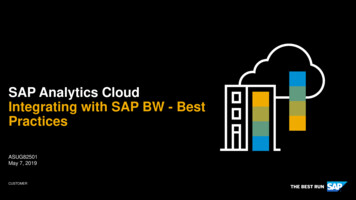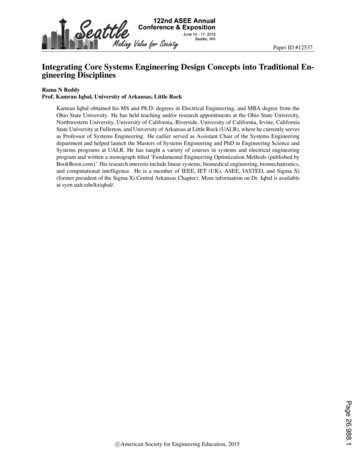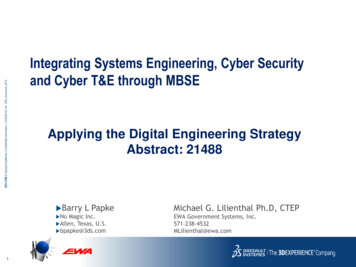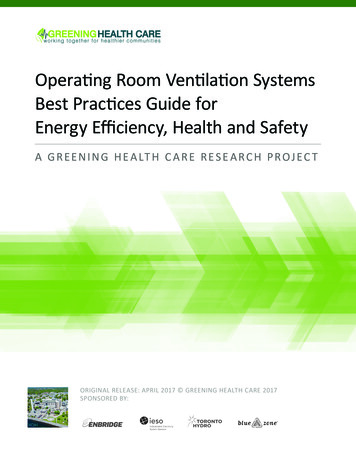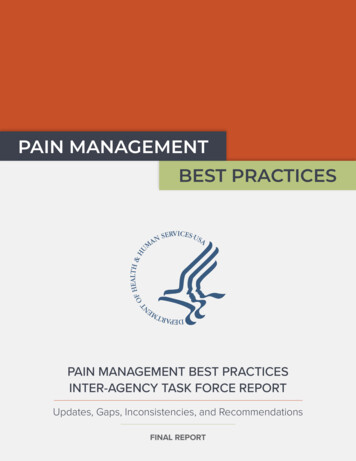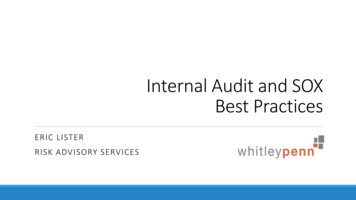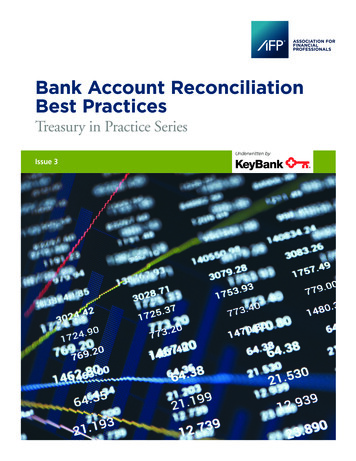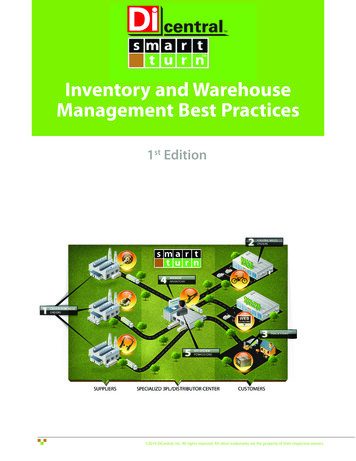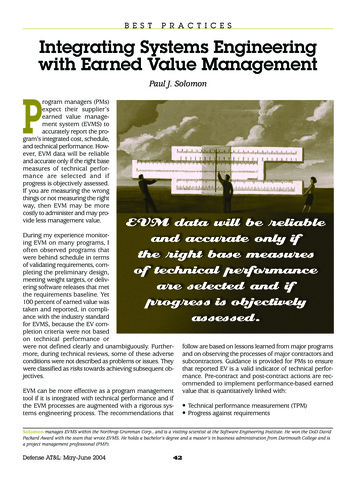
Transcription
B E S TP R A C T I C E SIntegrating Systems Engineeringwith Earned Value ManagementPaul J. Solomonrogram managers (PMs)expect their supplier’searned value manage ment system (EVMS) toaccurately report the program’s integrated cost, schedule,and technical performance. How ever, EVM data will be reliableand accurate only if the right basemeasures of technical perfor mance are selected and ifprogress is objectively assessed.If you are measuring the wrongthings or not measuring the rightway, then EVM may be morecostly to administer and may pro vide less management value.PDuring my experience monitor ing EVM on many programs, Ioften observed programs thatwere behind schedule in termsof validating requirements, com pleting the preliminary design,meeting weight targets, or deliv ering software releases that metthe requirements baseline. Yet100 percent of earned value wastaken and reported, in compli ance with the industry standardfor EVMS, because the EV com pletion criteria were not basedon technical performance orwere not defined clearly and unambiguously. Further more, during technical reviews, some of these adverseconditions were not described as problems or issues. Theywere classified as risks towards achieving subsequent ob jectives.EVM can be more effective as a program managementtool if it is integrated with technical performance and ifthe EVM processes are augmented with a rigorous sys tems engineering process. The recommendations thatfollow are based on lessons learned from major programsand on observing the processes of major contractors andsubcontractors. Guidance is provided for PMs to ensurethat reported EV is a valid indicator of technical perfor mance. Pre-contract and post-contract actions are rec ommended to implement performance-based earnedvalue that is quantitatively linked with: Technical performance measurement (TPM) Progress against requirementsSolomon manages EVMS within the Northrop Grumman Corp., and is a visiting scientist at the Software Engineering Institute. He won the DoD DavidPackard Award with the team that wrote EVMS. He holds a bachelor’s degree and a master’s in business administration from Dartmouth College and isa project management professional (PMP).Defense AT&L: May-June 200442
Development maturity Exit criteria of life cycle phases Significant work packages and work products.quantity of work. Robust systems engineering processesshould provide TPM and exit criteria for assessing tech nical maturity that are quantitatively linked to EV.Guidance for getting more value out of earned value isconsistent with the Department of Defense (DoD) RiskManagement Guide (Guide), the Interim Defense Acqui sition Guidebook (IDAG), and with industry standards thathave been adopted by the DoD:The following guidance will help a PM overcome EVM’slimitations. Processes for Engineering a System (EIA 632) Standard for Application and Management of the Sys tems Engineering Process (IEEE 1220) EVMS (ANSI/EIA-748-A-1998).Additional guidance is consistent with the Capability Ma turity Model -Integration (CMMISM).Better integration of systems engineering, risk manage ment, and EVM will benefit the PMs of both the acquisi tion and supplier organizations.EVM LimitationsWith regard to a PM’s needs, there are several limitationsof EVMS that can be overcome by integrating EVM withrobust systems engineering. First, EVM is perceived to bea risk management tool. However, EVMS was not de signed to manage risk and does not even mention thesubject.Unfavorable cost or schedule variances result from pastevents. They are already problems or issues. A cost over run indicates that, with 100 percent probability, subse quent cost objectives will not be achieved unless the planfor remaining work is revised.Risk Management Guide and TPMPer the Guide, risk management is concerned with futureevents whose outcome is unknown and with how to dealwith these uncertainties. That guidance is in contrast torisk-handling actions that should be reflected in integratedprogram planning, scheduling, and work packages. Inother words, risk handling actions become part of the EVperformance measurement baseline (PMB).In my opinion, the Guide’s statement that “periodic EVdata can provide indications of risk” is misleading. As dis cussed above, by the time a cost overrun is reported, theunfavorable event has occurred and there is a problemor issue, not simply a risk.The same premise—that deviations from a plan are is sues, not risks—should apply to TPM. Per the Guide: Technical . parameter values to be achieved . are fore cast in the form of planned performance profiles. Achieved values for these parameters are comparedwith the expected values. Events, tasks, and schedule resulting from the integratedplanning are linked with techniques, such as TPM. Linkage provides a significant monitoring tool, givingspecific insights into the relationships among cost,schedule, and performance risks.Third, EVMS does not require precise,quantifiable measures. It states thatobjective earned value methods arepreferred but it also states that man agement assessment (subjective) maybe used to determine the percentageof work completed.Finally, EVMS states that EV is a measurement of the quantity, not quality,of work accomplished. A PM shouldensure that EV also measures the qual ity and technical maturity of techni cal work products instead of just thePercent Required ValueAn example of a TPM planned performance profile thatSecond, earned value is a derived measure. Consequently, also shows achieved values and a tolerance band is shownits effectiveness to integrate technical and cost perfor in Figure 1.mance depends on its base measuresand on the capabilities of the systemsengineering processes that are em FIGURE 1. TPM Plan and Achievementployed on a 00Achieved Values43Defense AT&L: May-June 2004
However, some PMs classify TPM as a risk managementtechnique and do not integrate the planned performanceprofile into the schedules and work packages. Later, ifachieved values for these parameters fall short of the ex pected values, neither the schedules nor the earned valueshow a behind-schedule condition.Mike Ferraro describes DCMA research and pilot tests forintegrating TPM and EVM (“TPM, a PM’s Barometer,” PM,November-December 2002). The earliest research, pub lished in 1995, found that there was not clear linkage be tween technical parameters and work packages. Ferraroconcluded that this continues to be an issue.So how can a PM obtain contractual commitment to in tegrate TPM and EVM? Fortunately, there are two indus try standards that provide specific guidance for TPM thatare consistent with the Guide: IEEE 1220 and EIA 632.Both standards provide guidance for TPM planning andmeasurement (Figure 2) and for integrating TPMs withEVM. The DoD has adopted both standards.A PM may require compliance with the TPM componentsof either of these standards in the solicitation. Anotherapproach is to provide financial incentives for contractorcompliance. After contract award, the PM may use theintegrated baseline review (IBR) to verify that the inte grated planning includes TPMs and that the EVM is quan titatively linked to achieved values in appropriate workpackages. If the PM uses simulation-based acquisitionand modeling & simulation as discussed in IDAG, thenthe achieved values should be credible. Finally, the PMshould address TPM achievement and reporting duringtechnical assessment reviews.of progress for EV that indicate objective progress towardsdevelopment, implementation, and testing of the re quirements.The Guide discusses product-related metrics that includerequirements traceability and requirements stability.Progress against requirements, including the percentageof requirements that are traced upwards and downwardsand those that are validated, would be a highly effectivebase measure of earned value. It is especially importantto validate the requirements baseline early in develop ment and prior to the start of design by the prime andsubcontractors.The industry standards’ guidance for assessing progressagainst requirements is shown in Figure 3 (page 46).Design MaturityThe Guide discusses design maturity as a product-relatedmetric and provides examples of design maturity mea sures. Adherence to the standards will support the re quirement in DoD Instruction (DoDI) 5000.2 for a designreadiness review during system development and demon stration. The design readiness review assesses design ma turity as evidenced by such measures as: Number of subsystem and system design reviews suc cessfully completed Percentage of drawings completed Planned corrective actions to hardware/software defi ciencies Adequate development testing.Objective assessment of a system’s design maturity, incompliance with the standards, would also be a soundbasis for earned value.Other Systems Engineering Best PracticesIEEE 1220 and EIA 632 provide additional guidance forsystems engineering process improvement regarding progress, plan FIGURE 2. TPM Planning andning, and measurement. It may beused to select performance-based IEEE 1220: 6.8.1.5earned value measures. A PM maychoose to mandate compliance with Performance-based progresspertinent components of the stan measurementdards in the solicitation or to provideother incentives for compliance.TPMs are key to progressivelyassess technical progressProgress AgainstRequirementsMaster schedules and PMBs often re flect the tasks that were proposed, es Track relative to time with datestimated, and negotiated. However,established as to when:tasks that formed a basis of estimate- Progress will be checkedfor negotiation are not necessarily- Full conformance will be metthose that should be planned and Use to assess conformance totracked during program execution.requirementsThe PM should select base measuresDefense AT&L: May-June 200444MeasurementEIA-632: GlossaryPredict future value of keytechnical parameters of the endsystem based on currentassessments Planned Value profile is timephased achievement projected Achievement to date Technical Milestone whereTPM evaluation is reported
Exit CriteriaThe standards discuss the importance ofholding technical reviews at the end of a stageof development or a life-cycle phase to assurethat all exit criteria have been met. IEEE 1220is especially helpful by providing exit criteriafor a preliminary design review (PDR) and adetailed design review. Some of the exit criteriafor a PDR are: Prior completion of subsystem reviews Determination whether total system approachto detailed design satisfies the system baseline Mitigation of unacceptable risks Resolution of issues for all subsystems, products, and life cycle processes Definition of exit criteria in a systems engineering management plan or other technicalplan.A PM should review these plans with the supplierand reach agreement on the validity and sufficiency of the exit criteria during theIBR. It is also recommended thatthe work packages that measureprogress against requirements anddevelopment maturity be reviewed to understand the timephased plan for meeting the exitrequirements, the related EV techniques, and the base measures.Systems Engineering WorkProductsThe systems engineering processgenerates significant work products that should be included in integrated planning and measuredwith earned value.The process products of IEEE 1220are: Requirements baselineValidated requirements baselineFunctional architectureVerified functional architecturePhysical architectureVerified physical architecture. Validated logical solution representation Verified design solution.Depending on the selected standard, these work products should be included in the master schedule and inwork packages. Additional recommendations for workproducts are provided below in a discussion of the CMMI.The process products of EIA 632 are: System technical requirementsLogical solution representationsPhysical solution representationsSpecified requirementsValidated system technical requirementsBad Rap for Level of Effort (LOE)Many PMs expect that the percentage of LOE budgetshould not exceed a certain level. I believe that settingan arbitrary maximum threshold for LOE can increasecontract costs and cause management to waste timeby focusing on the wrong things. It costs money to45Defense AT&L: May-June 2004
practicable to measure. Non-technical work may fit this definition.FIGURE 3. Progress Against RequirementsIEEE 1220EIA 6326.8.1.5 Performance-basedprogress measurement6.8.6 Track Product Metrics4.2.1 Planning process,Req. 10: Progress againstrequirements6.8.1.5 d) Assess: Assess Progress comparing Development maturity to datecurrently defined system Product’s ability to satisfydefinition against requirementsrequirementsa) Identify product metrics and6.8.6 Product metrics atexpected values:pre-established control points enable: Quality of product Overall system quality evaluation Progress towards satisfyingrequirements Comparison to planned goalsd) Compare results againstand targetsrequirementsmeasure processes and progress. But as Navy Rear Adm.Dave Antanitus wrote in PM, “Be careful here—justbecause you can measure something does not mean itis a useful metric!” (“The Business of Metrics,” MarchApril 2003).Many tasks that are measurable are not indicators of tech nical performance. Examples are technical assessmentmeetings and recurring reports, such as cost performancereports (CPR). If a CPR is delivered late, there is no sched ule impact on a subsequent activity and no impact onfinal costs. So why incur the costs to measure CPRs dis cretely or to analyze schedule variances?The same is true for technical assessment reviews, suchas technical interchange meetings (TIMs), PDRs, and finaldesign reviews. Per IEEE 1220 and EAI 632, a purpose ofthe reviews is to assess progress and development ma turity. However, it is common practice to base earnedvalue on completion of the milestone event (TIM or PDRwas held) instead of on the quantified assessment ofprogress and maturity. For a PDR, if earned value werebased on the event instead of the assessment and if thepreliminary design did not meet the exit criteria, thenearned value would mask a behind-schedule condition.Likewise, the master schedule would be misleading if thePDR event showed completion despite a shortfall in tech nical performance.It would be cheaper to designate non-technical tasks asLOE, to manage LOE cost performance, and to apply moremanagement attention to technical performance. BothEIA 632 and IEEE 1220 focus on technical progress. Thebudget for non-technical tasks, such as preparing for andconducting a PDR, could be planned as LOE even if theLOE percentage exceeded arbitrary limits. The EVMS stan dard discusses that LOE is supportive work that is imDefense AT&L: May-June 2004A PM should be careful when ana lyzing summary earned value infor mation. A summary of only the dis crete tasks that measure technicalperformance should be prepared. Theperformance-based earned value willshow schedule and cost variances thatare not distorted by LOE content.Also, the related cost performanceindex will be a truer indicator of fu ture costs. LOE should be summarizedand analyzed separately.Additional ResourcesThe industry standards provide in formation as to what to do, and theyprovide a basis for acquisition man agement. Process models like CMMI provide informationfor implementing processes. The CMMI provides a frame work for process improvement towards integrating sys tems engineering and EVM.The Carnegie Mellon Software Engineering Institute’spublication Using CMMI to Improve EVM ( www.sei.cmu.edu/ ) provides information on the followingprocesses and topics: Requirements developmentRequirements managementMeasurement and analysisProcess and product quality assuranceRisk managementTypical work productsPerformance-based earned value.Guidance for requirements-based planning is providedin “Practical Software Measurement, PerformanceBased Earned Value” (CrossTalk: The Journal of DefenseSoftware Engineering, Sept. 2001, www.stsc.hill.af.mil/crosstalk ).A contractor may be compliant with EVMS but fail to trulyintegrate measurement of cost, schedule, and technicalperformance. A PM should ensure that integrated plans,schedules, and the earned value PMB are linked with thecontract requirements, TPMs, and unambiguous exit cri teria. By requiring or encouraging suppliers to adhere toindustry standards for systems engineering or engi neering processes, EVM will provide more reliable infor mation.Editor’s note: The author welcomes comments and ques tions and can be reached at SolomonPBEV@msn.com.46
Solomon manages EVMS within the Northrop Grumman Corp., and is a visiting scientist at the Software Engineering Institute. He won the DoD David Packard Award with the team that wrote EVMS. He holds a bachelor’s degree and a master’s in business administration from Dartmout

